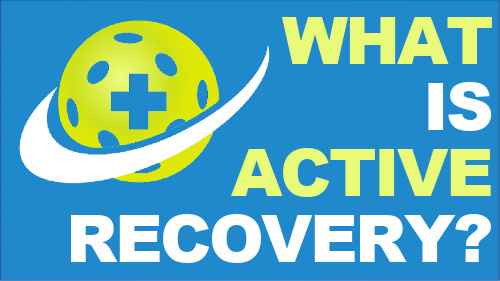Your body takes a beating when you play pickleball or exercise, but the recovery phase is just as important as the training phase. While it’s essential to give your body a break and rest, there’s a new way to power through your recovery period: active recovery. But what is active recovery and is it better than a rest day? Active recovery is a form of low intensity exercise during the recovery period after a workout. The goal of this type of workout is to flush the lactic acid out of your muscles and improve circulation. This helps speed up muscle repair and can prevent injury. Active recovery usually involves low impact activities, such as walking, light jogging, biking, and swimming. The question then arises: is active recovery better than just resting and letting your body perform its natural healing process? Let’s dive in and find out.
What is Active Recovery?
Active recovery – or active rest – is an effective way to give your body a break from intense physical activity while still allowing yourself to be physically active. It involves low-intensity physical activities such as stretching, yoga, light walking, and foam rolling, which help to reduce muscle fatigue and prevent injuries.
Benefits of Active Recovery
As I shared in the very first episode of the podcast, pickleball has a problem. We don’t take the physical exertion factor in pickleball seriously. Another challenge is that our bodies do not recover from physical exertion as quickly as that once did. However, many of us don’t want to wait the requisite time it takes for our body to fully recover. Luckily, active recovery helps solve this problem.
Active recovery has many benefits, including increased flexibility and range of motion, improved circulation and reduced soreness, and improved coordination and balance. Additionally, it can help to reduce stress levels and increase muscular endurance, allowing you to perform at a higher level during your next workout. By integrating this into your fitness routine, you can maximize the benefits of working out while minimizing the risks of overtraining and injury.
Strategies for Implementing
Active recovery can be applied in different ways depending on the individual and their goals. For example, a competitive athlete might use active recovery to maintain muscle mass and strength while still allowing their body to recover from intense training sessions. An active individual might use active recovery to improve overall health and energy levels while avoiding injury. Regardless of the goal, active recovery can be an effective way to boost performance and maintain a healthy lifestyle.
To begin implementing active recovery in your fitness routine, begin by scheduling a rest day between your workouts and focus on longer, lower intensity activities. Examples of activities that make great active recovery sessions include yoga, swimming, walking, and easy cycling. These activities serve to increase circulation and to move the body in a more relaxed manner. Incorporating active recovery into your fitness routine will help you stay ahead of fatigue and soreness, allowing you to get maximum benefit from your workouts.
Knowing When to Take a Rest Day
Knowing when to take a rest day is key to recovering from exercise, preventing injury, and improving performance. There are a couple of strategies for determining when to take a full on rest day. Tracking your resting heart rate is one. If your resting heart rate is elevated compared to its normal range when you wake up in the morning, it can signal your body is not done repairing and recovering. Similarly, if you track your heart rate variability and it is lower than normal, this is a signal that your system is not ready for activity and could use more rest. Products like the Morpheus, which I use nearly every morning and every pickleball session, can help you accurately track not just resting heart rate, but heart rate variability. It’s certainly not the only product on the market, but I like it because the app then takes these morning numbers into consideration when setting your cardio levels for that day.
Takeaway
Active recovery is a low intensity way of increasing your body’s ability to repair and recover in less time than full rest. Increasing blood flow increases repair efficiency and thereby decreases time to full physical recovery. As we age, that recovery time slows down, so this is a great technique for turning back time!

